Hebdomas
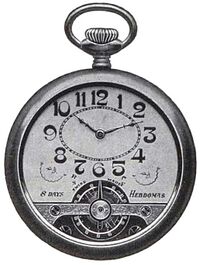
Hebdomas is a trademarked brand and design for an 8-day watch movement invented in 1888 and in production since at least 1898.
Overview
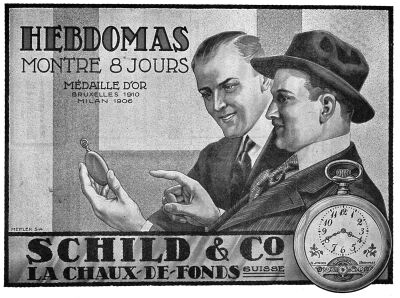
The "Hebdomas" name refers to the Ancient Greek concept of the end of the week. Also called sabbath or jubilee, Hebdomas could be used as a term for the seventh day or year. Although the famous watch movement had 8-day power reserve, the concept of a watch that would require winding just once a week is what gave it this name.
The original Hebdomas movement is an 8-day hand-winding watch movement. The massive mainspring barrel covers the entire diameter of the movement, rotating around the center similar to an automatic rotor. But perhaps the most recognizable feature of the movement is the exposed balance on the dial side, which is mounted to a dial-side bridge. This is typically gilded and engraved with a decorative floral motif.
The hour and minute hands are set off-center above the balance wheel, giving Hebdomas powered watches a distinctive haute horology look. Combined with the engraved bridge and exposed balance, this is reminiscent of high-end complicated watches of yesterday and today. But the Hebdomas movement has always been a lower-priced offering.
Most Hebdomas watches feature the "Hebdomas" name centered in the dial and "8 Jours" engraved twice, on either side of the balance. Most also feature a flower or arrow design above this. Many also feature circular or inset numerals at all 12 positions on the dial, giving the look of a jumping hours design.
Due to its small size (15 or 19 ligne), the Hebdomas movement found its way into wristwatches quite early. Most examples are oriented with the crown at 3:00 and the exposed balance at 9:00, though some also have a "bullhead" design with the crown between the lugs at 12:00.
History
Irénee Aubry
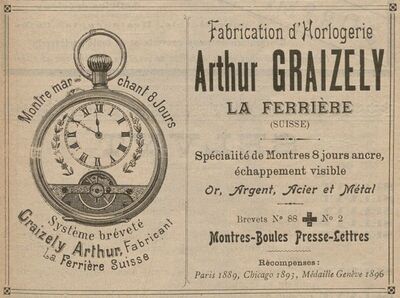
The 8-day movement was invented by Irénee Aubry of Saignelégier in 1888 in the Vallée de Joux in Switzerland. Aubry was originally from Muriaux but lived in La Ferrière by this time.
On May 20, 1888, Paul-Joseph-Irénée Aubry of Muriaux, Célestin-Arthur Graizely of la Ferrière, and Joseph-Ariste Godat of Les Bois formed a company called Aubry, Graizely & Godat in la Ferrière, to commercialize Aubry's design.
Aubry filed for a patent just 5 days after the Swiss Patent Office opened on November 14, 1889. The watch registered as CH88 was published on January 10, 1889, though it was not yet the final design. An addendum was registered on January 21, 1889, officially called CH88/2. This patent covered the basic design on the Hebdomas watch, including the open dial showing the balance and bridges and the full-diameter mainspring barrel.
The patent changed hands quickly: On February 17, 1889, patent CH88/2 was reassigned by Irénee Aubry to Aubry, Graizely, & Godat. Aubry formed a joint venture with Saignelégier watchmaker François Froidevaux on May 1, 1890 called Aubry & Froidevaux and left the partnership with Graizely and Godat on May 15, 1891, leaving patent CH88/2 to Aubry alone, as noted on June 2. Just 6 days later, Aubry licensed the patent to Ariste Godat, François Froidevaux, and Arthur Graizely. Finally, on December 1, Aubry & Froidevaux was dissolved, becoming F. Froidevaux alone. Froidevaux's company was dissolved on March 13, 1901, following his death. Ariste Godat's firm was dissolved on August 8, 1911.
Although it is not clear how many watches were manufactured at this time, an 1898 advertisement shows that Arthur Graizely was producing the 8-day watch (without using the Hebdomas name) in La Ferrière based on Aubry's patents. It also lists awards in Paris (1889), Chicago (1893), and Geneva (1896), presumably for Aubry's 8-day watch.
Arthur Graizely
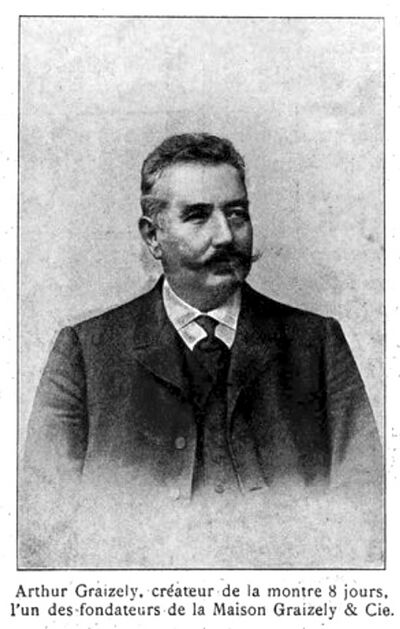
Hebdomas movements went into production under license by Arthur Graizely and his brother in La Ferrière, the watch used the names "Octava" and "Octodi". Graizely added more patents, including one for a power reserve indicator and another, dated October 9, 1901, that established the famous dial layout of the Hebdomas movement.
Graizely registered design patent 16125, which covered 5 models for "barillets décorés de montres huit jours", on December 11, 1908. This would be the key piece of intellectual property covering the Hebdomas watch.
The novel product caught the attention of Otto Schild of Grenchen, and the two set up a joint company in La Chaux-de-Fonds known as Graizely & Co in 1901. Schild also established a branch of Grizzly's company at Rue de la Serre 4 in La Chaux-de-Fonds on July 15, 1902 and also manufactured 8-day watches using the Graizely movement. By 1906, Graizely had registered the "Hebdomas" brand name and was producing both pocket watches and wristwatches with the familiar design. His company had acquired more patents by then, including a central winding pinion and digital time display.
Schild & Co
This Graizely-Schild partnership was dissolved between 1906 and 1915, with the license passing to a new company, Schild & Co, on May 28, 1913. The new firm took over production at the Graizely factory at Rue du Parc 137 in La Chaux-de-Fonds and would remain there for decades.
Among the assets acquired was design patent 16125, which covered 5 models for "barillets décorés de montres huit jours", which was transferred to Schild & Co. on January 17, 1914, and renewed on that day as well. Another key patent, 63390, covering a "mouvement de montre", was transferred to Schild & Co. on March 21, 1915. With these patents in hand, Schild & Co. now owned the Hebdomas design.
Production of Hebdomas watches by Schild is commonly said to have begun in 1913, though it is clear that many examples predate this. It received medals as early as 1896 in Geneva and was seen in Paris, Chicago, and Milan before 1910. It was said that the La Chaux-de-Fonds factory was producing 1000 examples per day with 1000 workers by 1918.
In 1920, Schild consolidated production of 8-day movements with the acquisition of the "Septima" brand. The company also manufactured an electric clock for automobiles known as the "Reform". Another Schild brand, "Orator", was established in 1944 and became the primary brand for these 8-day clocks. Production of the Hebdomas 8-day movement continued through the 1950s, though it was considered too large for wrist use by that time. After a short hiatus, it was re-launched by Schild in 1968 and remained in production in pocket watches until Schild entered insolvency in 1979.
Schild used many other brands in those years, including "Abyssal", "Adelco", "Air-Time", "Calendron", "Champion", "Christina", "Cortland", "Cosmos", "Cosmos-Electric", "Cristal Watch", "Cristama", "Cristina", "Dafinos", "Duchesse", "Duplex", "Eclair", "Electras", "Electrora", "Elivar", "Federate", "Fidelis", Florys", "Fullswing", "Globemaster", "Klement", "Mirax", "Perpetua", "Punktal", "Sonanto", "Starco", "Superior", "Tempus", "Texture", "Tresor", "Triumph", and "Vigor". The company was reorganized in 1986 as Fibeg SA in Bienne.
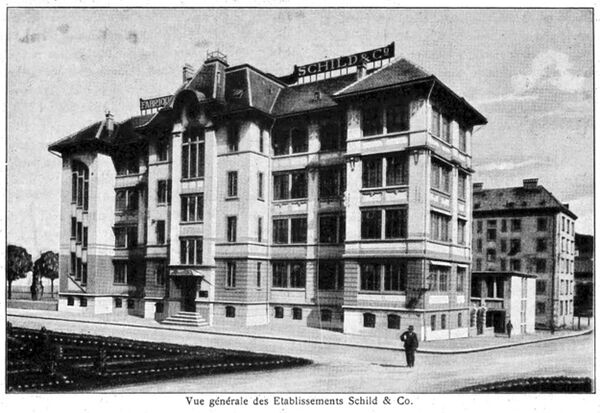
Xantia
In 1982, the design, trademark, and production of Hebdomas movements was taken on by Xantia, a private-label watch company. Hebdomas would become their primary owned brand through the 1990s, with variations on the 8-day movement serving as just one of several products under that name.
As Hebdomas, Xantia also produced an interesting and unrelated model, the Baladin, based on the ETA 2824 and said to be designed by Vincent Calabrese. Hebdomas used the Ascot name on both 8-day and Valjoux 7760 chronographs, and produced a jumping hours watch that ironically used an A. Schild movement. Many of these were available in gold, with prices rising over 20,000 Euros in the 1990s.
Production of the 8-day Hebdomas movement by Xantia continued into the 1990s, with advertisements sighted in 1991.
Kolber
In 2002, Europa Star reported that Kolber was the new producer of Hebdomas pocket watches. This Geneva-based company had been founded in 1983 as a producer of moderately-priced watches. Kolber's Hebdomas watches were listed at just CHF 2,000, far below Xantia's positioning, and were more of a novelty line among skeletonized models. Within a few years, Kolber appears to have moved further downmarket into the fashion watch range below CHF 1,000 and abandoned the Hebdomas line.
Patents
- CH88 "Nouvelle disposition du mécanisme des montres de toutes dimensions, particulièrement applicable aux montres-bijoux et anx montres marchant huit jours et plus" - Registered by Irénée Aubry, Saignelégier, November 19, 1888 - Reassigned (with CH88/2) to Aubry, Graizely & Godat, La Ferrière, April 30, 1891 - Reassigned to Henri-Albert Didisheim, La Chaux-de-Fonds, April 17, 1903 - Radiation noted December 17, 1903
- CH3060 "Nouveau système de montres" - Registered by Irénée Aubry, Saignelégier, December 13, 1890 - Radiation noted January 29, 1893
- CH4764 "Indicateur de marche et de développement du ressort pour montres de un à huit jours de marche pouvant servir de quantième simple" - Registered to Arthur Graizely, La Ferrière, March 23, 1892 - Radiation noted July 15, 1897
- CH5741 "Combinaison de rouages à grosse denture pour montres de petit calibre" - Registered by Irénée Aubry, La Chaux-de-Fonds, October 15, 1892 - Radiation noted February 13, 1896
- CH22279 "Montre à longue marche perfectionnée" - Registered by Arthur Graizely, La Ferrière, August 28, 1900 - Radiation noted June 1903
- CH24675 "Montre extra-plate à échappement visible" - Registered by Arthur Graizely, La Ferriére, October 9, 1901 - Radiation noted February 23, 1905
- CH27545 "Montre à longue marche perfectionnée" - Registered by Irénée Aubry, La Chaux-de-Fonds, February 3, 1903 - Radiation noted June 1, 1905
- CH27549 "Montre à longue marche et échappement visible, avec seconde au centre" - Registered by Irénée Aubry, La Chaux-de-Fonds, February 17, 1903 - Radiation noted June 22, 1905
- CH28100470 "Montre à longue marche perfectionnée" - Brevet Additionnel by Irénée Aubry, La Chaux-de-Fonds, March 14, 1904
- CH34981 "Pendulette à huit jours de marche" - Registered by Irénée Aubry, La Chaux-de-Fonds, November 1, 1905 - Radiation noted March 5, 1908
- CH39165 "Fond de boite de montre" - Registered by Irénée Aubry, La Chaux-de-Fonds, March 11, 1907 - Reassigned to Société Horlogère Reconvilier on April 18, 1908 - Radiation noted July 9, 1908
- CH40663 "Mouvement de montre" - Registered by Irénée Aubry, La Chaux-de-Fonds, November 21, 1907
- CH44117 "Montre" - Registered by Irénée Aubry, La Chaux-de-Fonds, April 29, 1908